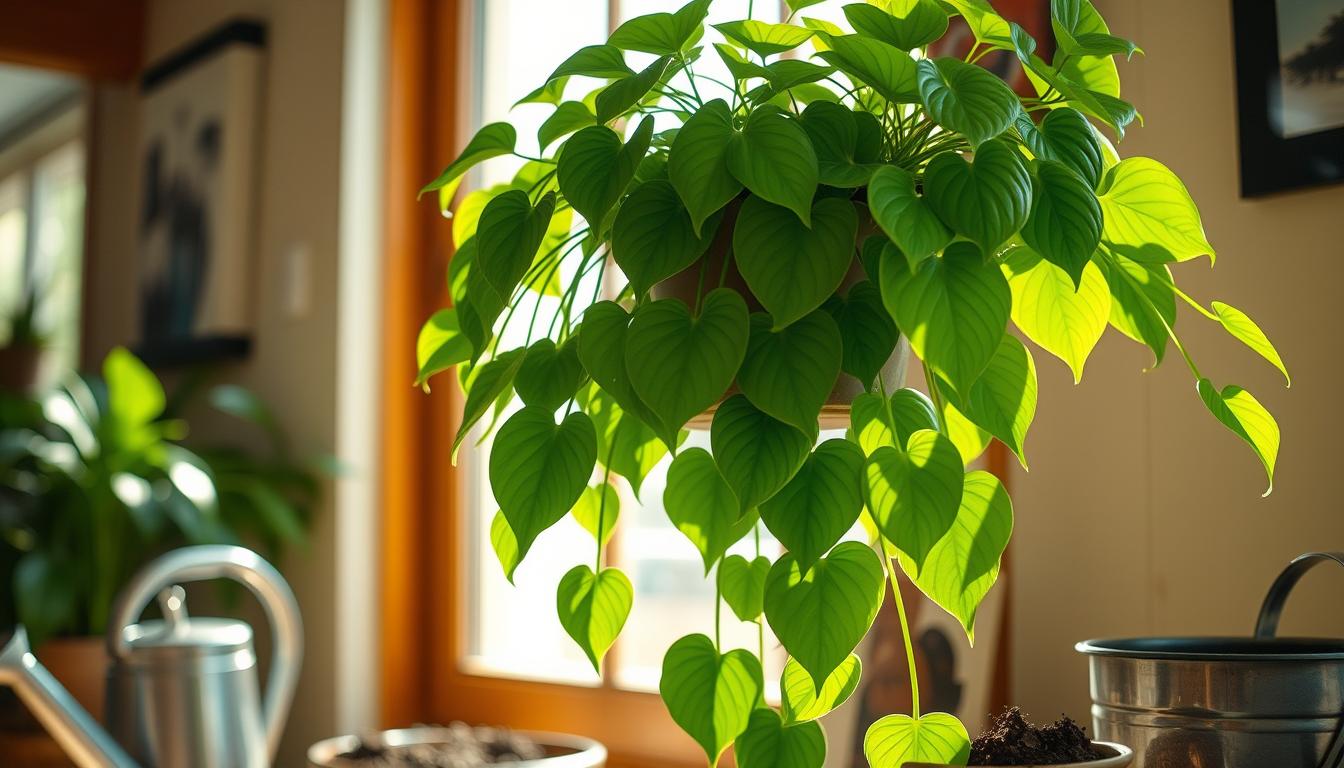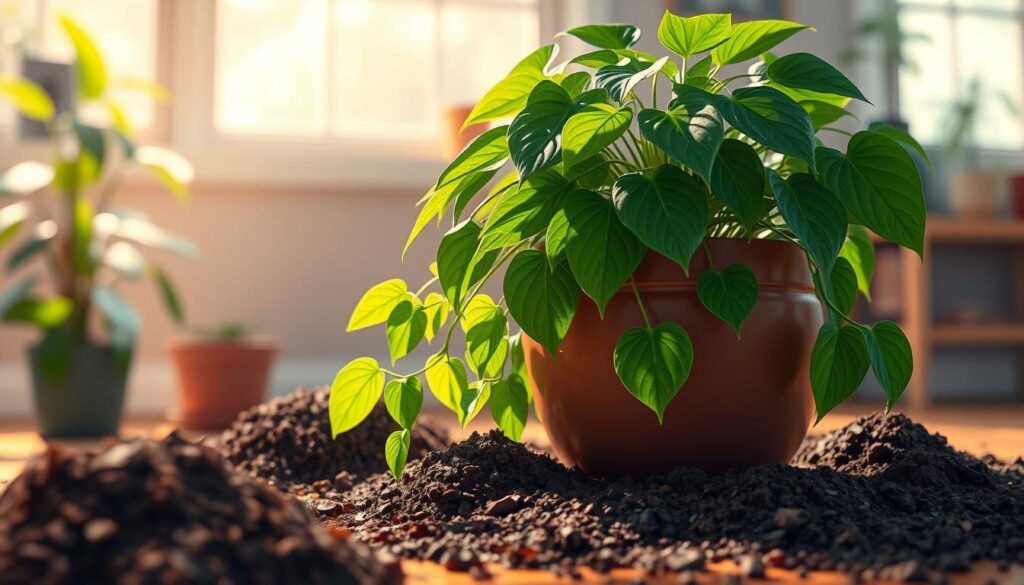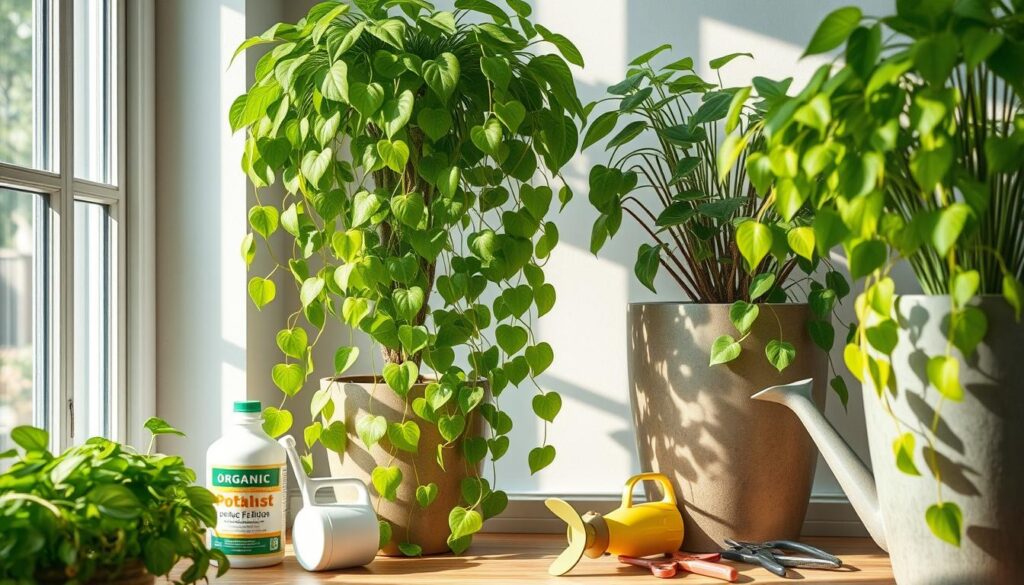New to houseplants? Pothos care is easy and needs little effort. It’s great for beginners because it grows fast and trails well. This makes it perfect for hanging baskets and shelves.
Learning to care for Pothos is simple. You’ll find it grows up to 12 to 18 inches a month. Mature Pothos can grow 20 to 40 feet long. They live 5 to 10 years with good care and can handle some neglect.
With the right care, Pothos makes your home beautiful. It’s perfect for brightening spaces or growing in low light. Follow easy care tips to keep your Pothos happy and healthy for years.
Introduction to Pothos Care
When you bring a Pothos plant home, you add beauty and a natural air purifier. It helps clean the air and can reduce stress. To keep your Pothos happy, learn the best care tips.
Pothos plants are easy to care for. They like bright, indirect light. This makes them perfect for rooms with big windows or skylights.
What Makes Pothos Special?
Pothos plants are easy to care for and can grow fast. They can reach up to 24 inches in a year. They’re great for hanging baskets or climbing up trellises.
Benefits of Having Pothos in Your Home
Pothos plants are not just pretty. They clean the air and can help reduce stress. By following a care guide, your Pothos will thrive and bring many benefits to your home.
- Natural air purification
- Stress reduction
- Low-maintenance care
- Adaptability to a range of environments
Understanding Pothos benefits and following a care guide will keep your plant healthy. Enjoy the many advantages it brings to your home.
Understanding Pothos Varieties
Knowing about Pothos varieties is key to caring for your plant. There are many types to pick from. Each one has its own look and needs for indoor care.
Creating a good care plan is important. It means giving your plant the right light, water, and food. For example, Neon Pothos needs more light than others. Marble Queen Pothos needs bright light to keep its color.
Here are some common Pothos varieties and what makes them special:
- Golden Pothos: large, deep-green and yellow variegated leaves
- Marble Queen Pothos: highly variegated leaves with a slower growth rate
- Neon Pothos: solid neon-green leaves that require more light
- Jade Pothos: dark green leaves with a fast growth rate
Knowing about Pothos varieties helps you care for your plant better. Whether you’re new or experienced, the right care makes your plant happy and healthy.
| Pothos Variety | Leaf Size | Growth Rate |
|---|---|---|
| Golden Pothos | 2-4 inches | Fast |
| Marble Queen Pothos | 2-5 inches | Slow |
| Neon Pothos | 2-4 inches | Medium |
| Jade Pothos | 4-8 inches | Fast |
Ideal Light Conditions for Pothos
Knowing the right light for Pothos is key. Pothos does well in many light setups. This makes it perfect for places with little natural light. Learning to care for Pothos means knowing the difference between low and bright light.
For the best growth, put your Pothos in bright, indirect light. Direct sun can burn the leaves, making them brown and unhealthy. In low light, the plant grows long and sparse, looking for more light. Artificial lights, like LED grow lights, help in low-light spots, especially for colorful Pothos.
Low Light vs. Bright Indirect Light
To get the right light for your Pothos, think about these points:
* South-facing windows are very bright but can burn Pothos if too close.
* North-facing windows have the least light, which is not good for growth.
* East-facing windows have morning direct light, great for Pothos.
* West-facing windows get strong afternoon sun, so place Pothos carefully to avoid burn.
Understanding Plant Light Needs
Rotate your Pothos often to keep it growing evenly and prevent leaning. Change where you place it with the seasons to match the sun’s changes. By following these tips and knowing the best light, your Pothos will flourish and beautify your home.
Soil Requirements for Healthy Pothos
Caring for Pothos plants means knowing the best soil. A good Pothos care guide says to use a well-draining potting mix. This mix stops water from making the soil too wet, which can harm the roots.
A good mix has things like orchid bark and perlite. These help keep the soil right for your Pothos. Miracle-Gro® Indoor Potting Mix is a great choice. It’s well-drained and full of nutrients.
- Ideal soil pH range: 6.1 – 6.8
- Importance of well-draining soil to prevent waterlogged soil
- Need for a balanced potting mix that contains a combination of ingredients
Knowing about soil helps your Pothos grow well. Water it well and let the top 2 inches dry before watering again. Fertilize every few months to keep it healthy. With the right care, your Pothos can grow up to 10 feet long indoors.
Watering Your Pothos
Watering is key for indoor Pothos care. You must avoid too much or too little water. Check the soil often to find the right balance.
Water your Pothos once a week or every two weeks usually. Let the top 2 inches of soil dry out before watering. Stick your finger into the soil to check.
Water in the morning or evening in hot weather. This helps your Pothos stay healthy. For more tips, visit trusted houseplant guides.
Here are some watering tips for your Pothos:
- Use room temperature water for best health.
- Mist your Pothos often to keep leaves green and humidity high.
- Water less in winter, every 3-4 weeks.
Follow these tips for a healthy Pothos. Watch how your plant reacts to water changes. Adjust your indoor Pothos care as needed.
Fertilization Tips for Thriving Pothos
To keep your Pothos plant healthy, fertilizing is key. It gives your plant the nutrients it needs to grow. Fertilizing is a big part of Pothos care essentials.
Learning Pothos plant care tips shows fertilizing is very important. Pothos plants use soil nutrients, which run out fast. Indoor plants need fertilizer every two months because of this.
Best Types of Fertilizers
Liquid fertilizers give nutrients directly to the plant. This helps avoid too much or too little fertilizer. Using a good fertilizer like Pothos Plant Food helps your plant grow big and green.
When and How to Fertilize
In the growing season (spring and summer), use liquid fertilizer once a month. Start with slow-release fertilizer in spring and summer. But, don’t fertilize in autumn and winter.
By following these Pothos plant care tips, your plant will get the nutrients it needs. Fertilize regularly and ask for help if you need it.
| Fertilizer Type | Application Frequency |
|---|---|
| Liquid Fertilizer | Once a month during growing season |
| Slow-Release Fertilizer | At the start of spring and summer |
Pruning and Propagating Pothos
Learning about pruning and propagation is key for a healthy Pothos. A good Pothos care guide will tell you to prune often. This keeps your plant bushy and looking great.
Use clean, sharp tools for pruning. Prune in spring, summer, and early fall. Cut stems with 3 to 4 nodes. Put them in water or light soil.
Here are some tips for pruning and propagating Pothos:
- Prune your Pothos at least once a year to maintain health and appearance.
- Take stem cuttings with at least 3 to 4 nodes for successful propagation.
- Place cuttings in water or a light soil mix, and change the water every 7-14 days.
- Roots can begin to grow from stem cuttings submerged in water within approximately 2 weeks.
Follow these tips to keep your Pothos healthy. Always use clean tools and give it the right light and water. With care, your Pothos will be a beautiful addition to your home.
| Propagation Method | Time to Root | Success Rate |
|---|---|---|
| Water | 2 weeks | High |
| Soil | 2-3 months | Medium |
Common Pothos Pests and Problems
When you take care of your Pothos plant, knowing about pests and problems is key. Regular indoor Pothos care helps avoid these issues. But, knowing how to spot and fix them is also important.
A good Pothos care routine means watching for pests like spider mites, mealybugs, and scale insects. These pests can harm your plant, making leaves turn yellow, leaving sticky stuff, and creating webs. By following the right Pothos plant care instructions, you can stop these problems and keep your plant healthy.
Some common problems with Pothos plants include:
- Root rot from too much water and bad drainage
- Leaf spot disease from fungi or bacteria
- Powdery mildew in humid places
By sticking to a consistent Pothos care routine and knowing about pests and problems, you can keep your Pothos happy and healthy. Always follow the right indoor Pothos care steps for the best results.
| Pest/Problem | Cause | Solution |
|---|---|---|
| Spider mites | Dry, warm conditions | Increase humidity, use neem oil |
| Mealybugs | Overwatering, poor air circulation | Improve air circulation, use insecticidal soap |
| Root rot | Overwatering, poor drainage | Improve drainage, reduce watering |
Ideal Temperature and Humidity for Pothos
To keep your Pothos happy, knowing about temperature and humidity is key. The best temperature for Pothos is between 60-80 degrees F. It should never go below 50 degrees F.
Pothos likes a humid place, best between 40% to 60% humidity. If it’s too dry, leaves might turn brown or droop. Too wet can cause yellow leaves and a bad smell.
To make the air more humid, you can group plants together. Or use a humidifier. The Flora Pod is great for keeping humidity just right.
Here are some tips to keep your Pothos happy:
- Keep your Pothos away from drafts and extreme temperature changes
- Use a humidifier to keep the air moist, especially in dry winter
- Watch how your plant reacts to changes in temperature and humidity, and adjust as needed
By following these tips, you’ll make a great home for your Pothos. Always watch your plant and change things if it needs it. With the right temperature and humidity, your Pothos will thrive.
| Temperature Range | Humidity Level | Optimal Conditions |
|---|---|---|
| 60-80 degrees F | 40-60% | Ideal for Pothos growth and health |
| Below 50 degrees F | Below 40% | |
| Above 80 degrees F | Above 60% |
Creating a Pothos Display in Your Home
The Pothos care guide and best practices for Pothos care help your plant stay healthy. But there’s more fun! Pothos plants have long vines and can fit in many ways in your home.
You can use hanging baskets, shelves, or trellises to show off your Pothos. Let it climb and trail to fill corners or frame doorways. Your Pothos will bring life and beauty to any room.
When you move your Pothos around the house, change how you water and light it. A Pothos in a bright spot needs more water than one in a dark corner. This way, your Pothos will stay happy and green for a long time.







Pingback: "What Are the Best Low Light Indoor Plants? Discover 10 Perfect Varieties. - Trusted House Plant Guide
Pingback: The Ultimate Beginner's Guide to the Most Wanted Indoor Plant for 2025 - Trusted House Plant Guide